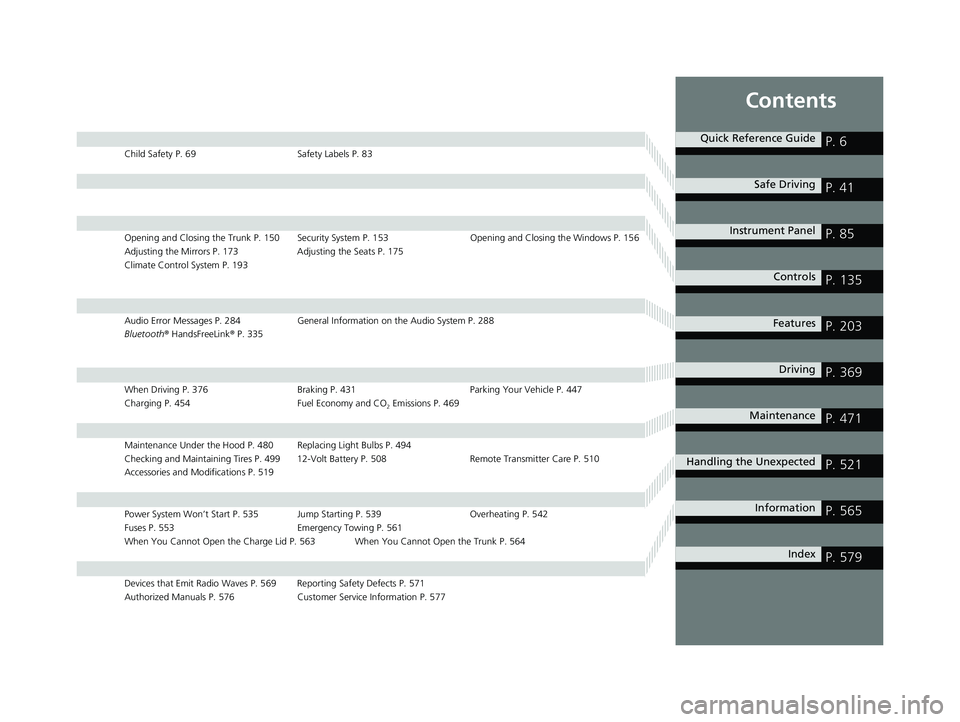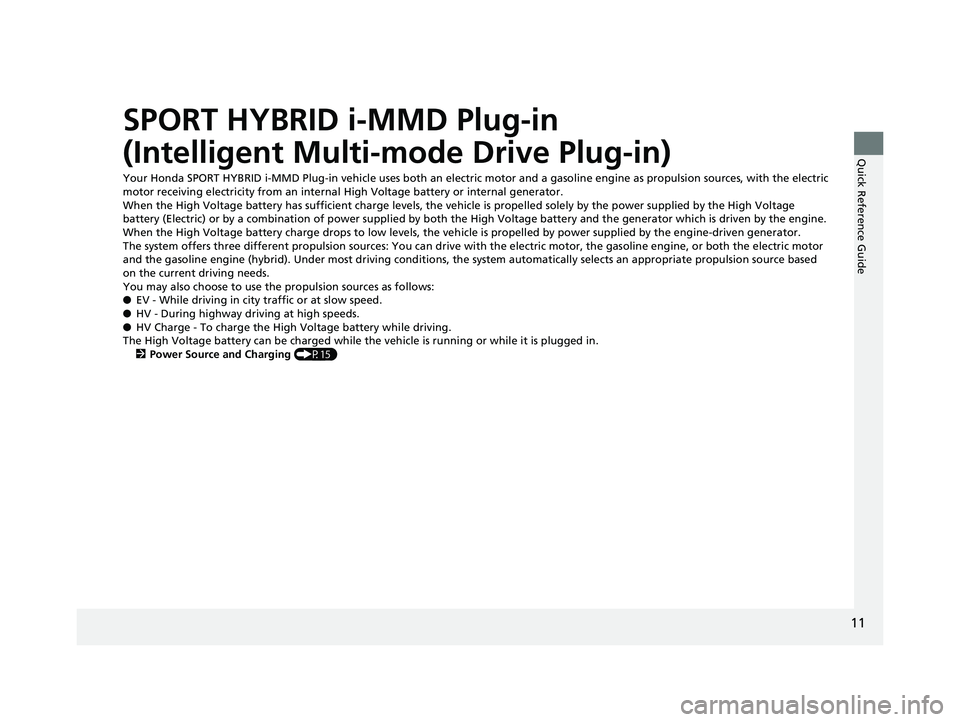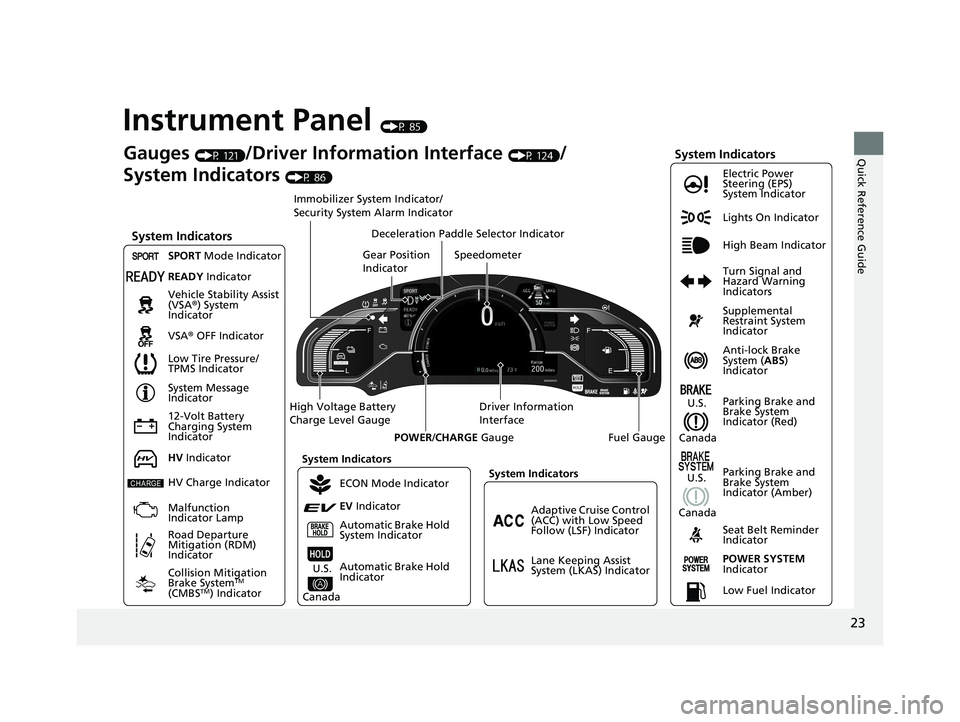Page 7 of 591

ContentsChild Safety P. 69 Safety Labels P. 83
Opening and Closing the Trunk P. 150 Security System P. 153 Opening and Closing the Windows P. 156
Adjusting the Mirrors P. 173 Adjusting the Seats P. 175
Climate Control System P. 193
Audio Error Messages P. 284 General Information on the Audio System P. 288
Bluetooth ® HandsFreeLink ® P. 335
When Driving P. 376 Braking P. 431 Parking Your Vehicle P. 447
Charging P. 454 Fuel Economy and CO 2
Emissions P. 469
Maintenance Under the Hood P. 480 Replacing Light Bulbs P. 494
Checking and Maintaining Tires P. 499 12-Volt Battery P. 508 Remote Transmitter Care P. 510
Accessories and Modifications P. 519
Power System Won’t Start P. 535 Jump Starting P. 539 Overheating P. 542
Fuses P. 553 Emergency Towing P. 561
When You Cannot Open the Charge Lid P. 563 When You Cannot Open the Trunk P. 564
Devices that Emit Radio Waves P. 569 Reporting Safety Defects P. 571
Authorized Manuals P. 576 Customer Service Information P. 577 Quick Reference Guide
P. 6 Safe Driving
P. 41 Instrument Panel
P. 85 Controls
P. 135 Features
P. 203 Driving
P. 369 Maintenance
P. 471 Handling the Unexpected
P. 521 Information
P. 565
Index
P. 57918 CLARITY PHEV CSS-31TRW6000.book 7 ページ 2017年8月31日 木曜日 午後2時4 9分
Page 13 of 591

11
Quick Reference Guide
SPORT HYBRID i-MMD Plug-in
(Intelligent Multi-mode Drive Plug-in) Your Honda SPORT HYBRID i-MMD Plug-in vehicl e uses both an electric motor and a gasoline engine as propulsion sources, with the electric
motor receiving electricity from an internal High Voltage battery or internal generator.
When the High Voltage battery has sufficient charge levels, the vehicle is propelled solely by the power supplied by the High V oltage
battery (Electric) or by a combination of power supplied by both the High Voltage battery and th e generator which is driven by the engine.
When the High Voltage battery charge drops to low levels, the ve hicle is propelled by power supplied by the engine-driven gener ator.
The system offers three different propulsion sources: You can dr ive with the electric motor, th e gasoline engine, or both the e lectric motor
and the gasoline engine (hybrid). Under most driving conditions , the system automatically selects an appropriate propulsion sou rce based
on the current driving needs.
You may also choose to use the propulsion sources as follows:
● EV - While driving in city traffic or at slow speed.
● HV - During highway driving at high speeds.
● HV Charge - To charge the High Voltage battery while driving.
The High Voltage battery can be charged while the vehicle is running or while it is plugged in.
2 Power Source and Charging (P15)18 CLARITY PHEV CSS-31TRW6000.book 11 ページ 2017年8月31日 木曜日 午後2時 49分
Page 16 of 591
14
Quick Reference Guide Power Source Electric Hybrid Engine
EV indicator
POWER / CHARGE
Gauge The readings on the blue bar The readings on the white bar
Driving state Light to mid acceleration or cruise ●
Only the electric motor provides
propulsion to the wheels. Mild to heavy acceleration ●
The electric motor provides
propulsion to the wheels. ●
The engine drives the generator,
supplying electricity to the electric
motor for added power or to the
High Voltage battery for charging. The vehicle is cruising at a higher
speed. ●
Propulsion is provided by the
engine, coupled through the gears
to the transmission. This is
indicated by the gear icon in
the display.
Energy flow Comes
on Goes
off18 CLARITY PHEV CSS-31TRW6000.book 14 ページ 2017年8月31日 木曜日 午後2時 49分
Page 17 of 591

15
Quick Reference Guide
Power Source and Charging Electric Source When the High Voltage battery is sufficiently charged, the vehicl e is propelled solely by the electric motor. When the remainin g power of
the High Voltage battery drops to a certain level, the vehicle switches to HV.
u To maintain charge levels, you can, at any time, use the HV button to switch the vehicle to HV.
2 Switching to HV (P16)
u If the High Voltage battery charge drops below levels that are necessary for the vehicle to run in Electric, you can enable cha rging of
the battery by pressing and holding the HV button.
2 Switching to HV CHARGE (P17)
Hybrid Source In hybrid, the electric motor receives powe r either from the High Voltage battery or from the generator which is driven by the engine, or
from both the High Volt age battery and generator.
Engine Source When the vehicle is driving under light load within a certain speed range, the engine provides direct power to the wheels.
Charging the High Voltage Battery (P455)
There are a number of ways to charge the High Voltage battery. You can:
● Use the Level 2 240V charger, or the portable charging cable located in the trunk.
● Use a public charging station.
● Enable HV Charge and let the battery charge while the vehicle is being driven.
When charging from an external source, you ca n schedule the start and end time for charging.
(P467)
Regenerative Energy and Regenerative Braking When the vehicle is decelerating or descending a hill, the electric motor acts as a generator that recovers
a portion of the energy that was used to accelerate the vehicle.
The regenerative force that the electric motor applie s to the wheels when it is in regenerative mode
helps to slow the vehicle down in a manner similar to engine braking which is used on conventional
vehicles. If you want to slow the vehicle down at a faster rate without using the brakes, you can use the
deceleration paddle selector to increase the resistive force. 18 CLARITY PHEV CSS-31TRW6000.book 15 ページ 2017年8月31日 木曜日 午後2時 49分
Page 19 of 591

17
Quick Reference Guide
HV Charge To enable HV Charge , press the HV button until the HV Charge indicator turns on.
While the vehicle is in HV Charge, the High Voltage battery will continue to charge until the battery charge level display reac hes 12
segments. Once the battery reaches this leve l, the vehicle switches to HV. You can canc el HV Charge before the battery reaches 12 segments
by pressing the HV button.
When the vehicle is in HV Charge, priority is given to the charging of the High Voltage battery. While the battery is being charged, the
engine may run at a higher RPM than usual. The time it takes for the battery to be charged to 12 segments varies depending on d riving
conditions.
The high voltage battery can be charged to 12 segments in after about 1 hour of high-speed driving. HV Charge is not recommende d for
city driving or other driving situations when you need to stop frequently or driv e slowly. In these situations, press the HV button again to
disable HV Charge. If you are in HV and approaching a destination where the vehicle can be charged, you can turn off HV and use the
remaining battery power to drive.
TimeHigh Voltage battery when charged to 12 segments
HV
ChargeRemaining power of the
High Voltage battery Press and hold
the HV button. Press the HV button.
EV EVHVu Any time the HV button is pressed
while in HV or HV Charge, the
system returns to EV operation.18 CLARITY PHEV CSS-31TRW6000.book 17 ページ 2017年8月31日 木曜日 午後2時 49分
Page 25 of 591

23
Quick Reference Guide
Instrument Panel (P 85)
Lights On Indicator
System Indicators
12-Volt Battery
Charging System
Indicator Anti-lock Brake
System ( ABS )
IndicatorVehicle Stability Assist
(VSA ® ) System
Indicator
VSA ® OFF Indicator Electric Power
Steering (EPS)
System Indicator
System Indicators High Beam Indicator
Seat Belt Reminder
IndicatorSystem Indicators
System Message
Indicator
Parking Brake and
Brake System
Indicator (Red)Supplemental
Restraint System
Indicator
Gauges (P 121)
/Driver Information Interface (P 124)
/
System Indicators (P 86)
Low Tire Pressure/
TPMS Indicator Turn Signal and
Hazard Warning
IndicatorsSpeedometer
Automatic Brake Hold
System Indicator Parking Brake and
Brake System
Indicator (Amber)SPORT Mode Indicator
Collision Mitigation
Brake System TM
(CMBS TM
) IndicatorRoad Departure
Mitigation (RDM)
Indicator Immobilizer System Indicator/
Security System Alarm Indicator
Automatic Brake Hold
IndicatorREADY Indicator
POWER SYSTEM
IndicatorGear Position
Indicator
Fuel GaugeDriver Information
InterfaceHigh Voltage Battery
Charge Level Gauge
POWER / CHARGE Gauge
Low Fuel IndicatorAdaptive Cruise Control
(ACC) with Low Speed
Follow (LSF) Indicator
Lane Keeping Assist
System (LKAS) IndicatorDeceleration Paddle Selector Indicator
System Indicators
ECON Mode Indicator
EV Indicator
U.S.
CanadaHV Indicator
HV Charge Indicator
Malfunction
Indicator Lamp U.S.
Canada U.S.
Canada18 CLARITY PHEV CSS-31TRW6000.book 23 ページ 2017年8月31日 木曜日 午後2時 49分
Page 46 of 591
44 uu For Safe Driving u Important Safety Precautions
Safe Driving ■ Handle high-vol tage with care
Familiarize yourself with the charging instructions and warnings supplied in this
manual and on the quick reference card. If using a public charger, also observe the
charging station manufacturer’s instructions. 18 CLARITY PHEV CSS-31TRW6000.book 44 ページ 2017年8月31日 木曜日 午後2時 49分
Page 85 of 591
83
Safe Driving
Safety Labels Label Locations These labels are in the locations shown. They warn you of potential hazards that can cause serious injury or death. Read these labels
carefully.
If a label comes off or becomes hard to read (except for the U. S. dashboard label which may be removed by the owner), contact a n
authorized Honda Clarity Plug-In Hybrid dealer for a replacement.Dashboard
Air Conditioner System
U.S. models
Canadian models
Radiator CapU.S. models only
Charging Lid
U.S. models Canadian models
PCU
U.S. models Canadian models
High Voltage Battery System
Coolant Reserve Tank CapSun Visor
U.S. models Canadian models Motor Coolant
Reserve Tank Cap
Actuator Lid
U.S. models Canadian models18 CLARITY PHEV CSS-31TRW6000.book 83 ページ 2017年8月31日 木曜日 午後2時 49分